If you’re interested in learning how to get rid of mice without killing your pets, you’ve come to the right place.
Fortunately, it’s a situation that I haven’t had to deal with of late. Since moving to our house in the countryside, we’ve had very few problems with mice. When we lived right in town – in an old house that was poorly insulated and even more poorly sealed – we had a ton of mice.
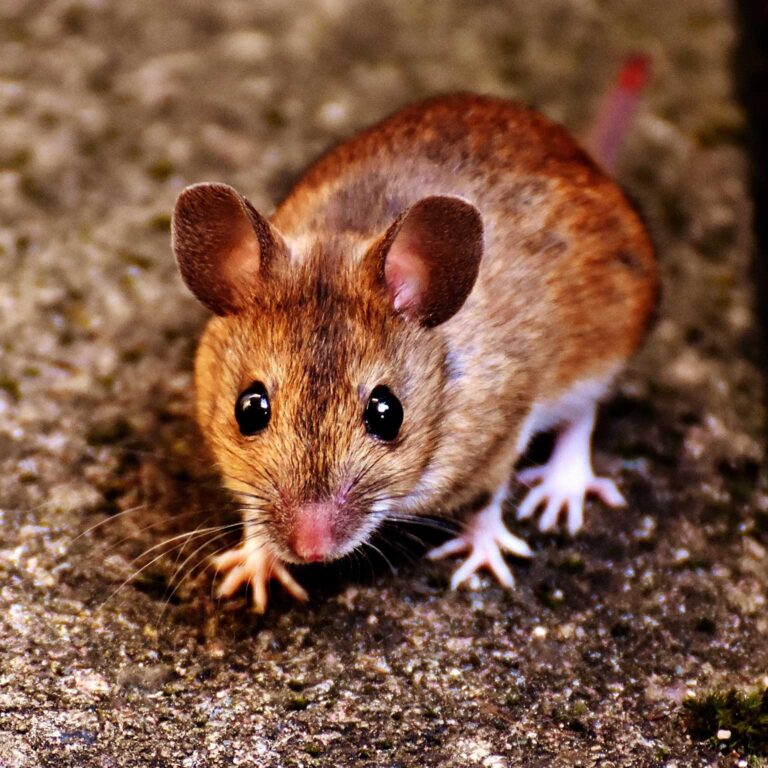
In fact, just by tapping on the walls in our rental house, we could hear the mice scurrying around! Not an ideal situation, but luckily, we were just temporarily renting so we didn’t have to take any action.
We haven’t had to deal with mice in our house, since it’s a relatively new build. However, a few days ago, my husband thought he saw a mouse scuttling around near the feed supply for our chickens.
That was a bit concerning, because we definitely don’t want mice getting into our food. They can cause a whole host of problems – which I’ll tell you all about in a moment.
Luckily, it ended up not being a mouse, but instead a baby bunny that he had mistaken for the smaller rodent at first glance. Crisis averted.
Getting rid of mice on our farm would be a bit of a challenge, primarily because we have a pet dog (and dozens of other farm animals) to worry about.
While most people would choose to deal with a mouse infestation by setting baits and leaving them out where mice are usually found, that wouldn’t be an option for us with all of our animals roaming around.
Fortunately, it is possible to get rid of mice without killing your pets – you just need to try a few unique strategies in order to do so.
Signs of a Mouse Infestation
Mice come inside looking for food, water, and shelter. Your home – along with your barns, chicken coop, garage, shed, and even your garbage bins – provide the perfect habitat.
Usually, mice will nest in warm areas that are somewhat secluded, such as the space surrounding water heaters, refrigerators, or furnaces.
Mice are incredibly opportunistic. They can squeeze into seemingly impossible spaces – a space of as little as ¼ of an inch is enough for a mouse to slip through.
If given the opportunity, a mouse can sneak inside at any time of the year (although mice more often come indoors during the cold winter months).
These tiny rodents feed primarily on bits of cereal, grains, and nuts. However, mice will eat anything they can find – and anything you might have available is fair game! Some favorite options include produce, dry goods, pet food, chocolate, cheese, and bird seed.
Mice have super sharp teeth, so the first sign of infestation that you might notice is gnawed pieces of food packaging. They can easily tear through both plastic and paper packages.
You might find shredded bits of material all around your home, too, as mice scavenge around, looking for pieces of paper and cotton to use in their nests.
You might also notice that there is food debris scattered on your shelves or in other unusual places. A lesser-known sign of a mouse infestation is a sudden, unexplained short in a light fixture or another appliance.
This is because mice are famous for chewing on (and damaging) wires. That’s yet another reason why you need to get rid of a mouse infestation once you notice signs of a problem – they can cause fires.
Mice also leave behind droppings that can collect in cabinets, near appliances, and under sinks. The droppings can sometimes be hard to see, unless there are a lot of them, so you may want to use a flashlight when you are looking for droppings in dark corners or near cabinets.
You might find the mouse nests, too. These are usually made out of things like string, shredded paper, fabric, or other pliable materials. You might hear mice scratching around in the walls at night (which, as I mentioned, was our most obvious sign of infestation in our old house).
If you have a mouse problem, you notice a musty odor. Sometimes mice leave behind markings on the walls as they move – they tend to scuttle along the walls.
Finally, if you have pets – which you likely do, if you’re reading this article – you may notice that they begin to behave strangely. They might start scratching under furniture and appliances or barking for seemingly no reason. These are all good signs that you have mice in the house!
Table of Contents
Why You Need to Get Rid of Mice
Mice can bring a variety of health hazards into the home, so it’s important to be aware of the best ways to get rid of mice and begin treating the problem immediately. As soon as you see the signs of infestation mentioned above, you need to act.
And rest assured – if you see one mouse, there’s a good chance that there are dozens more nearby. So don’t assume that you perhaps only have one mouse living in your house. That’s probably not the case.
Unfortunately, once an infestation sets hold, it can be difficult to get rid of the mice in your house. A single mouse can reproduce up to ten times per year – so a breeding pair of mice can become a huge problem for quickly.
Mice won’t bite out of random ill will, but they will latch on if you disrupt them. Mice can spread all kinds of diseases, including salmonella, typhus, and the plague.
Mice can spread a variety of diseases, too. This is done both directly, through their bites, as well as indirectly, through their waste. Mice can spread Lassa fever, Hantavirus, and even leptospirosis. Mouse droppings can also trigger allergic and asthmatic reactions.
Your first step in dealing with a mouse infestation is to make sure it’s actually mice that you are dealing with. Mice are small, usually less than eight inches in length, and have large rounded ears.
They have excellent eyesight and like to gnaw and nibble. They can be found all over the world, except for extreme northern or mountainous regions.
Preventing Mice
The easiest way to get rid of mice is to prevent them from ever coming inside. Here are some tips.
Be Careful About Animal Feed
Whether it’s chicken food, pig food, or bird food, make sure your feed supply is well-protected. This will help keep out mice along with other invading rodents, like rats and squirrels.
Install squirrel guards on your bird feeders and put all food in airtight containers (preferably made out of metal so the mice can’t chew through).
Do not leave any food or water out overnight, either. This was one reason why we thought we may have a mouse problem – we are raising Cornish Cross chickens that like to eat (constantly) so we have been leaving a bit of food in the troughs at the end of the day. This can attract mice, so be careful!
Move the Woodpile and Trash Cans
Make sure all trash cans, compost bins, and wood piles are at least 100 feet from your house. That way, even if mice do decide to take up residence in those spots, you won’t have to deal with them in the house!
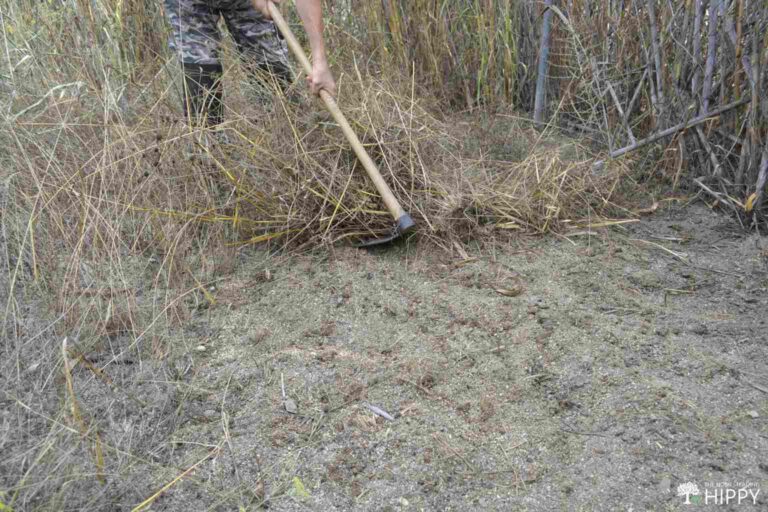
Cut Back Vegetation
Similarly, it’s not uncommon for us to see mice scurrying along in the tall grass outside of our house. I don’t mind them there – but I definitely don’t want them coming inside.
Therefore, I make it a point to keep all the vegetation (both grass and shrubs) trimmed back so mice aren’t tempted to come inside.
Clean Up Inside
Indoors, your best line of defense against mice is to maintain a house that is spotless. If you spill any food, clean it up immediately, and make sure you wash your dishes right after you use them.
All food waste and trash should be stored in mouse-proof containers. Don’t leave pet food out overnight and try to vacuum or sweep regularly to make sure there aren’t any crumbs on the floor.
How to Get Rid of Mice – Without Hurting Your Pets
Start by Checking Entrances
The first step you should take in getting rid of a mouse infestation is to closely examine your home for any potential sign of infestation.
Check common entry points like the spaces where your pipes enter the basement. You can also check areas where pipes connect to various appliances, such as those that rest under your sink or fall behind the refrigerator or oven.
Mice can also get into the house by slipping in along basement foundations or around chimney vents or openings.
They can also slip in along baseboards or high points where various walls come together. They don’t mind hanging out in outdoor storage areas- like near compost bins, garages, garbage bins, or sheds – either.
When you examine these entrances, take the time to closely cover and seal any gaps you may find. Mice cannot chew through steel.
Therefore, you will want to use a wire mesh screen to seal up any openings rather than more “edible” materials like insulation. You can also caulk or use steel wool around mouse holes, too.
Once you know that no more mice can get inside your house, you can take steps to eradicate their populations for good.
Be Careful Using Baits and Snap Traps
The most common method that people use to get rid of mice is to use snap traps or “bait stations” – rat poison.
These are effective and don’t cost very much per use. However, they aren’t a good idea if you have pets or small children in the home.
If your cat or dog happens to ingest mouse bait, also known as rodenticide, it can produce disastrous effects. Your pet could suffer from symptoms of poisoning like vomiting, seizures, blood in the urine, and lethargy. It can be potentially fatal.
Unfortunately, pets tend to be curious – they want to know what’s going on in that mouse trap! Many baits and traps look like toys or pet food, which can be very confusing to a pet.
This can lead to a ton of unintended effects, so if you have pets, you may be better off trying another method of mouse control instead of a trap or bait.
And just so you know, you aren’t safe by just placing mouse bait or trap somewhere in which your pet can’t reach it.
If your cat or dog happens to eat a mouse that ingested rodenticide, that can make him or her very sick, too. Mice don’t always die immediately upon ingesting the poison, so this is, unfortunately, very common.
Glue Traps
Glue traps are a controversial but undeniably effective lethal trap that entails far less risk for pets when you have to use them in a close protection role in and around living areas.
As you might expect, glue traps use glue to ensnare and sometimes suffocate mice that approach them trying to get the bait tantalizingly located in the center of the pad.
Mice step on to the sticky, viscous adhesive on the pad and can no longer move, remaining in place until they dehydrate or, depending on how they get caught, suffering from positional asphyxiation and perishing.
Glue traps have some big advantages and that they are very easy to employ, affordable and present very little risk to most cats and dogs.
Sure, you might have to clean up a mess if they manage to get into it, and you’ll have a hell of a time getting the glue off of their fur, but they should not be any worse for the wear.
Also, don’t delude yourself into thinking you can use a glue trap and a non-lethal way. There is no easy way to free a mouse that has been caught by a glue trap, as you will break their tiny bones all to pieces assuming they are still alive when you find them.
It’s a pretty cruel way to go, and you should definitely dispatch any mouse that has been caught by one if it is still alive when you find it.
Consider Live Traps
Live traps are effective no-kill solutions that can be used to get rid of mice in your home.
You’ll have to check and monitor the traps more frequently, but if you have pets, the extra hassle can be worth it to protect the life and safety of your favorite four-legged friend (and I don’t mean the mouse, of course).
Live traps do have some significant advantages over most types of lethal trap, namely the fact that some of the most common and effective designs can hold many mice, are self-resetting and also allow the mice to stay alive inside, at least for a time, especially when they have bait to eat.
So long as you are diligent, this reduces the chances you’ll be dealing with dead mouse stench stinking up your house, and also dramatically increases the uptime of the trap compared to typical lethal designs.
My favorite, and one I have used with great success, is basically a metal box with a hinged top that has two gated entrances on opposite corners. The mice enter, pass over a teeter totter and then are locked inside until you come along and open the top.
I was able to eliminate a major infestation in my home over the course of a few nights using six of these traps strategically placed, and did not have to kill a single mouse.
I wound up catching more than 50 mice, and one trap had eight of the little rascals in there at a single time. These are an affordable trap that works!
The CDC doesn’t recommend using live traps because there is the risk of disease transmission. This is because you’ll be handling the live mouse and there’s a risk that you could be bitten.
Plus, it’s important to keep in mind that you will have to drive at least a mile away from your house to release the mouse.
Nevertheless, if you are vigilant about monitoring your live traps and you wear protective clothing while handling the live mice, you should be fine.
Bucket Trap
The bucket trap is a DIY solution, and sometimes an over-the-counter one, that can be used in both a lethal or non-lethal role depending on your objectives.
The design of a bucket trap varies slightly but always functions similarly. Two ramps on either side of the bucket allow mice to clamber up to the top which either has a roller going across the rim or else a platform that is precariously balanced as a teeter totter.
Another design involves placing a cardboard tube with bait above the bucket, which will fall along with the mouse when the animal tries to go for the bait, like so:
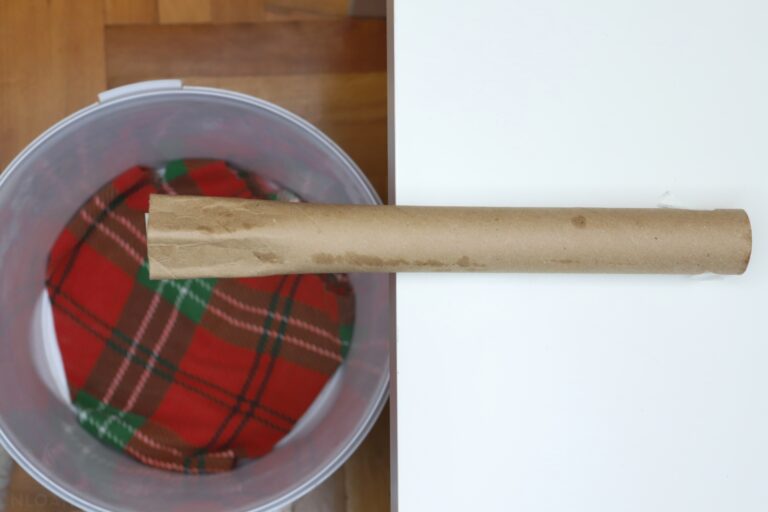
As you know by now, bait is positioned in the center of the roller or the tilting platform. When mice scamper out onto the roller or the lid to get at the bait, either will dump them into the bucket, containing them.
Here’s where the variability of the bucket trap comes into play. If kept dry and empty, the bucket trap can hold an awful, awful lot of mice who have no hope of climbing out.
This can allow you to relocate them without killing them. However, filling the bucket about a third of the way up with water turns it into a drowner trap that will kill the mice, using no poisons or other chemicals, when they run out of steam and can no longer swim.
Highly versatile, the massive capacity of the bucket trap lends it to outdoor depopulation efforts as well as use in attics, barns and sheds. In any case, they are totally harmless to cats and dogs alike.
Make sure you keep an eye on the bait and refresh it as necessary, as plenty of other animals could it get to it and remove it without falling victim to the trap!
Try an Ultrasonic Emitter
Ultrasonic emitters work by emitting pulses of ultrasound at high frequency. You and your pets won’t be able to hear them, but the mice will – and it will drive them crazy!
To keep the mice from getting used to the noise, get an ultrasonic emitter that changes the frequency and volume of its bursts.
Use Electronic Traps
Electronic traps are somewhat expensive lethal traps but “clean” and can be reused multiple times. They have a high success rate and work by killing a mouse with electric shock.
The units are totally enclosed – the mouse will run inside, where it will be electrocuted and killed. As you can imagine, these units pose no threat to pets since the entry points are too small for mice to get inside.
Deadfall
Sometimes you need a lethal trap in a hurry, but don’t have access to a purpose designed mouse trap. In this case, you can easily make your own using a 1 or two pound rock, large hardcover book or any other similarly shaped, weighty and rigid object along with some pencils or twigs and a little bit of bait.
A deadfall functions, as the name suggests, by dropping a heavy weight on the target animal. In the case of a mouse, even something like a larger hardback book might as well be a mountain. The dead fall itself, the weighted object, is it held up or propped up by cordage or by sticks, with the bait a fixed to a trigger that will jiggle the assembly and release the weight, flattening the mouse before they can get away. Usually victim-activated, you can also trigger these yourself from a hiding place using thread.
So if you have only one or two mice tormenting you wherever you happen to be it is entirely possible to snuff them out without spending money or time procuring a dedicated mouse trap.
The disadvantage of a deadfall is that they can only activate one time before they must be carefully reset, and that you must ensure the weight is heavy enough to do the job. Typically if the weight is five times heavier than the target, you can depend on it.
Now, to clarify, there is no danger to other animals and pets so long as you construct the deadfall properly!
It is important to keep in mind the relative weight of the deadfall itself and the target animal are significant, but the actual weight of the deadfall is quite light: Your average field mouse will weigh anywhere between 15 and 30 g- really tiny!
Following the proportions recommend for an effective deadfall (5x weight of target to reliably maim/kill), you’d need a weight that is only 150g for the larger mice. That’s not even half a pound!
Now, even if we went well beyond the recommended weight of the deadfall for the largest mouse, just for insurance of a clean kill, you’ll still only use an object that weighs 2 lb at the most and is suspended only a foot off the ground at its highest.
Place it just high enough to let it slam down on the tiny mouse, but not so high that it poses any real threat to even a chihuahua.
Trust me when I say that while your dog or cat might well spoil your deadfall trap, they aren’t at any risk of being injured by it unless you are making a deadfall for a far larger animal.
If you decide to suspend a small boulder, piece of furniture, anvil, grand piano, etc. then, yes, your pets and also people are at risk! Keep it small and there will be no danger- except to the mouse!
Space and Place Traps Properly
When you’re setting up mouse traps, it’s important that you set them correctly in order to actually get rid of the mice.
If you’re using a live trap or another kind of trap that requires bait, you’ll want to use a calorie-dense food, like chocolate or peanut butter.
You may be able to use baits like yarn or cotton balls in the winter, too, when mice are looking for materials to build their nests.
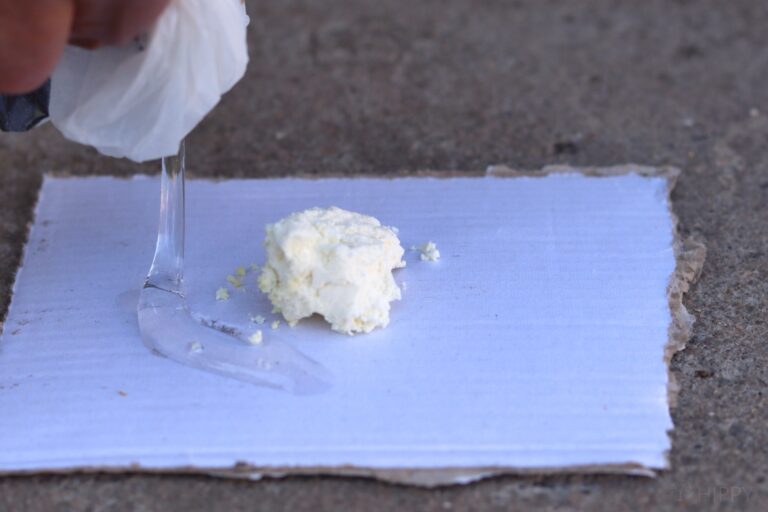
Wear gloves whenever you set mouse traps and deal with their contents. Set your traps close to walls – mice tend to run along the walls – and ideally in concealed areas, like behind cabinets.
Not only is this where mice tend to congregate, but you also won’t have to worry about your curious pets bumping into the traps here, either.
A common mistake that many people make when setting mouse traps is that they don’t use enough of them.
You are going to want to set your traps close together, about two feet apart. In some places, you may even want to set your traps a few inches apart.
Try a Natural Repellent
These aren’t always effective, and they do take some time to work even when they are.
However, mice have a strong sense of smell, and spraying some natural mouse repellent might help prevent these pests from coming inside! Luckily, this tip won’t harm your pets, either.
Mice don’t like the scent of garlic, peppermint oil, and cayenne pepper. Consider making a brew by adding one of these oils to your favorite homemade cleaner.
Spray liberally around the entry points to your home – or simply soak cotton balls in the essential oil of your choosing and place them in various cracks and crevices around your home. It should do the trick!
You can also sprinkle dry herbs and spices in places where mice are known to congregate. Cayenne pepper, peppermint and cinnamon are s that are particularly effective.
Grow Repellent Plants
There are some plants that mice despise the smell of – mint is one example. Mint can also deter other pests, like ants, flies, and fleas, so consider planting some around the foundation of your home.

It should spread quickly with little maintenance required on your part and it will prevent mice from coming inside your home.
Let Your Pets’ Help to Get Rid of Mice
Ironically, one of the best ways you can get rid of mice is to enlist the help of your pets themselves!
As you probably already know, most cats – as well as many dogs – are avid hunters, and will do a good job of seeking out mice and getting rid of them when they find them.
All you have to do is set your pet loose!
Hopefully, by following these tips, you won’t have to deal with a mouse in the house – and if you do, you can get rid of it safely without harming your pets.
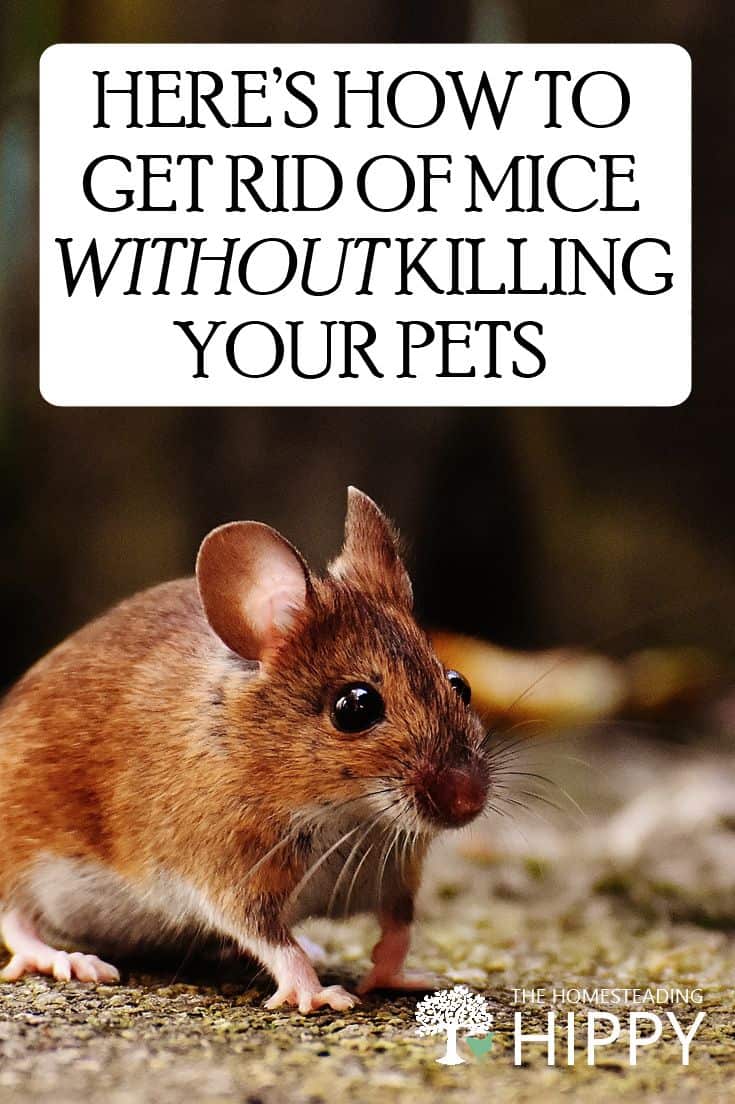

Rebekah is a full-time homesteader. On her 22 acres, she raises chickens, sheep, and bees, not to mention she grows a wide variety of veggies. She has a huge greenhouse and does lots of DIY projects with her husband in her ever-growing homesteading endeavor. Learn more about Rebekah here.
